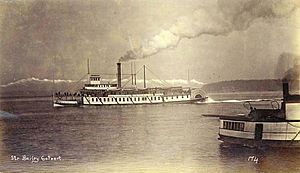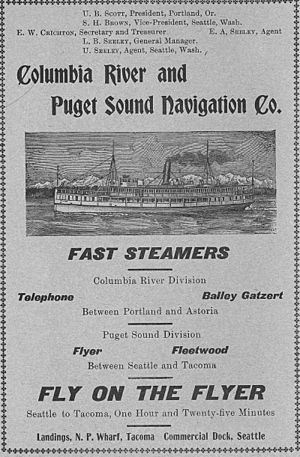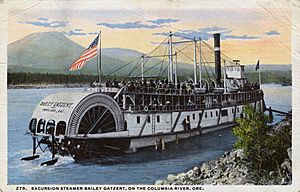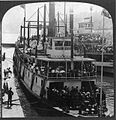Bailey Gatzert (sternwheeler) facts for kids
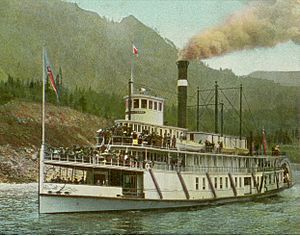
Bailey Gatzert approaching Cascade Locks, circa 1910
|
|
Quick facts for kids History |
|
|---|---|
| Name | Bailey Gatzert |
| Route | Puget Sound (several routes), Columbia River |
| Builder | J.J. Holland yard, Ballard, Washington |
| Launched | 1890 |
| In service | 1890 |
| Out of service | 1925 |
| Fate | Dismantled |
| Notes | Reconstructed and enlarged 1907, later converted to auto ferry |
| General characteristics | |
| Type | inland steamship |
| Tonnage | 276 |
| Length | 177 ft (53.9 m), and after reconstruction, 191 ft (58.2 m) |
| Beam | 32 ft (9.8 m) |
| Depth | 8 ft (2 m) depth of hold |
| Decks | three (freight, passenger, boat) |
| Installed power | twin horizontally mounted steam engines, wood-fuel until 1907; thereafter an oil-burner |
| Propulsion | sternwheel |
| Speed | 18 knots (approx. 20 miles per hour) |
| Capacity | Licensed in 1907 to regularly carry 350 passengers and 625 on excursions. |
The Bailey Gatzert was a famous steamboat that used a large paddlewheel at its back (called a sternwheel). It traveled on the Columbia River and Puget Sound from the 1890s to the 1920s. People thought this ship was one of the best of its time. It was named after Bailey Gatzert, an early businessman and mayor of Seattle. He was a close friend of John Leary, who paid for the ship to be built.
The Bailey Gatzert likely carried more passengers than any other steamboat on the Columbia River. Many people also believed it was one of the most beautiful riverboats. This was because its upper deck extended all the way to the front of the ship.
Contents
- Building the Bailey Gatzert
- Ship's Power and Size
- Launch Day!
- Early Journeys
- New Owners and Exciting Races
- Moving to the Columbia River
- Life on the Columbia River
- 1907 Rebuild
- New Races and Challenges
- Accidents and Incidents
- Final Years and Legacy
- Return to Puget Sound
- What Happened to the Ship?
- Remembering the Bailey Gatzert
- Images for kids
Building the Bailey Gatzert
The Bailey Gatzert was built for John Leary. It cost about $100,000 to construct. This was a lot of money back then!
The ship was built at the shipyard of John J. Holland in Ballard, Washington. The powerful engines for the steamboat came from a company in Pittsburgh, Pennsylvania. Holland was a skilled shipbuilder. He had already built other famous steamboats like the Wide West.
The engines were supposed to arrive by mid-July 1890. But they were late. Workers were busy day and night to finish the ship's cabin structure. The pilot house, where the captain steers, was built next.
More parts, including the sternwheel shaft, arrived in August. The boilers, which make steam for the engines, were delayed even longer. They finally arrived in October.
Ship's Power and Size
The Bailey Gatzert had two large steam engines. Each engine had a 22-inch wide opening and an 84-inch stroke. These engines could push the steamboat at over 20 miles per hour. When it was first launched, people said it was the fastest steamboat on Puget Sound. Its engines produced 1,300 horsepower. The sternwheel had 17 paddles, each 18 feet long.
The ship's boiler was a special steel type, also made by James Rees & Sons. The Bailey Gatzert was originally designed for day trips. It did not have sleeping rooms. It burned wood for fuel, using up to three cords of wood every hour!
The ship was about 177 feet long over its main hull. Its width, or beam, was about 32 feet. The depth of its hold was 8 feet.
Launch Day!
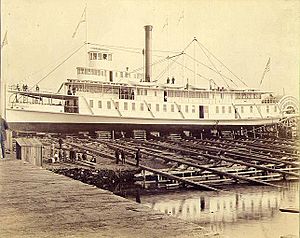
The Bailey Gatzert was launched on Saturday, November 22, 1890. About 1,500 people came to watch! The launch was set for 1:00 p.m. to wait for the right tide.
The steamboat was built on a special platform, or cradle. It was placed sideways to the water, 100 yards away. This was the longest sideways launch ever tried on the Pacific Coast.
Four hundred people were on board as the boat slid into the water. Captain J.J. Holland gave the signal. His young son, Willie Holland, broke a bottle of champagne on the ship's front.
The Bailey Gatzert already had its engines running when it entered the water. Captain George Hill was in the pilot house. He started the engines, and the ship began its first trip towards Seattle. Many important steamboat captains were on board. After the launch, some final work was done, like installing electric lights.
Early Journeys
Captain George Hill became the first captain of the Bailey Gatzert. Starting in December 1890, the ship ran twice a day between Seattle and Tacoma.
On January 19, 1891, the Bailey Gatzert took almost 300 people on a trip to Olympia, Washington. It made the trip in a record time of about three hours and 25 minutes.
However, the ship was taken off the Seattle-Tacoma route on January 28, 1891. There wasn't enough business to make it profitable. The Gatzert had lost about $2,000. Since it had no sleeping rooms, it couldn't be used for longer, overnight trips.
New Owners and Exciting Races
The Bailey Gatzert was soon sold to a new company called the Columbia River and Puget Sound Navigation Company. People also called it the White Collar Line. This company planned to run steamboats on both Puget Sound and the Columbia River.
By February 1891, the Bailey Gatzert was back on a route from Seattle to Tacoma and Olympia. It replaced a slower ship. The Bailey Gatzert was much faster, making the Seattle-Tacoma trip in just 1 hour and 45 minutes.
Race Against the Greyhound
On April 21, 1891, the Bailey Gatzert had an exciting race against another sternwheeler called the Greyhound. The race was from Tacoma to Seattle and back, a distance of 28 miles.
The Greyhound was a new ship, known for its large sternwheel. Rumors of the race spread quickly. Hundreds of people gathered at the docks in Tacoma to watch.
Both ships were ready to go. But just as the Gatzert was about to leave, its steering gear broke! It took 45 minutes to fix. The Greyhound waited patiently.
Finally, with the steering fixed, both steamboats left Tacoma at top speed. The Gatzert took the lead. By the time they reached Point Robinson, the Bailey Gatzert was far ahead. The Greyhound had used too much fresh water while waiting. Its engineer had to use salt water, which slowed it down.
As they neared Seattle, the Greyhound started to catch up. People on the Seattle docks were very excited! The Greyhound closed the gap, but the Bailey Gatzert still reached the dock first. However, on the return trip to Tacoma, the Greyhound won by one and a half minutes!
The Missing Greyhound Trophy
The Union Pacific railroad company had a new steamboat called the T.J. Potter. Captain Troup, who managed Union Pacific's ships, saw that John Leary and J.J. Holland had put a silver statue of a greyhound in the Gatzerts pilot house. This was to celebrate the Gatzerts fast time between Tacoma and Seattle.
Captain Troup bet Leary and Holland that if the T.J. Potter could beat the Gatzert in a race, they would have to give the greyhound trophy to the Potter.
A few days later, Captain Troup received a telegram from the Potter's captain: "Passed the Gatzert this morning and led her into Seattle. Time 1:22½". Troup immediately replied: "Get the dog." Later that day, he got another telegram: "Got the dog. It now adorns the pilot house of the T.J. Potter."
Moving to the Columbia River
In 1892, the Bailey Gatzert was moved to the Columbia River. It was used for special trips and as a backup boat. In 1895, it was completely updated and then started running between Portland and Astoria.
In June 1893, there were plans for the Bailey Gatzert to run trips to Clatsop Beach. By July 1893, it was taking tourists on trips through the Columbia River Gorge.
A Trip to San Francisco?
In July 1893, there was talk that the Bailey Gatzert might be sold to a company in San Francisco. The idea was to use it as a ferry between San Francisco and Oakland. If it had happened, the trip from the Columbia River to San Francisco would have been one of the longest ever for a sternwheeler on the Pacific coast. But the sale didn't happen. The companies couldn't agree on who would pay to move the ship.
Competition on the Astoria Route
In 1895, the Bailey Gatzert faced tough competition on the Astoria route. The Oregon Railway and Navigation Company had two fast steamers, the T.J. Potter and the R.R. Thompson.
To compete, the White Collar Line spent almost $20,000 to remodel the Bailey Gatzert. They wanted it to be "one of the finest sternwheel steamers afloat." They also used another ship, the Ocean Wave, for trips from Portland to Ilwaco. The Bailey Gatzert shared the Astoria route with the Telephone, which was said to be the fastest river steamer in the world.
New engines were put in the Bailey Gatzert. It also got a new upper deck with fourteen staterooms. These rooms were considered the best because they were quiet and had good airflow. The ship now had electric lights and new steam-powered steering.
Life on the Columbia River
The Portland-Astoria Route
In March 1895, the Bailey Gatzert made daily trips (except Sundays) from Portland to Astoria. It left Portland at 7:00 p.m. and Astoria at 7:00 p.m. for the return trip. Passengers could connect to Ilwaco, Washington from Astoria.
The Bailey Gatzert had a special four-note musical steam whistle. It had once been on the fast steamer Telephone. In March 1895, the whistle had some problems and sounded strange. But by March 28, it was fixed and sounded like its usual self.
By September 1895, the White Collar Line had two steamers running daily from Astoria to Portland. The Telephone was the evening boat. The Bailey Gatzert was the morning boat on most days.
Railroad Competition
A railroad from Portland to Astoria was finished in April 1898. Trains could travel from Portland to Astoria in just three and a half hours. This was much faster than the steamboats. The fastest steamboat trip was by the Telephone, which took 4 hours and 34 minutes. The railroad greatly reduced the need for river steamboat service.
By October 1899, ticket prices on the Gatzert's Portland-Astoria route were lowered to 50 cents. In December 1900, the Bailey Gatzert was taken out of service for repairs. It had been running constantly for almost two years. It returned to the Astoria route in April 1901.
Portland–The Dalles Route
The Gatzert didn't stay on the Astoria route for long. By May 1901, it was moved to a route up the Columbia River Gorge. About $25,000 was spent to remodel the ship for this new route. Its old engines were replaced with ones from the Telephone. Extra rudders were added to help steer in the fast waters of the Columbia Gorge.
The Bailey Gatzert was the first steamboat to make a round trip from Portland to The Dalles in one day. In June 1902, it set a record time on the trip from The Dalles to Portland.
In 1903, the White Collar Line merged with another company. This led to exciting races on the river between the Gatzert and other famous steamboats like the Hassalo and the Charles R. Spencer.
During the winter of 1903–1904, the Gatzert was taken off the Columbia Gorge route. In 1905, a new boiler was installed.
Lewis and Clark Exposition
During the Lewis and Clark Exposition in 1905, the Bailey Gatzert made two trips a day to Cascades Locks in the Columbia Gorge. A special song, "The Bailey Gatzert March," was even written for the steamboat!
1907 Rebuild
In 1907, the Bailey Gatzert was rebuilt with a new, longer hull. The engines from the Telephone were installed again. The ship was also changed from burning wood to burning oil.
Work on the Bailey Gatzert was rushed in April 1907. Its length grew by 15 feet. The old cabins were reused, but the back cabins on the upper deck were removed to create a walking area. The new Gatzert was launched on August 24, 1907. It was expected to carry 350 passengers normally, and up to 625 for special trips.
The rebuilt Gatzert had 50% more power than the original boat. Its first test trip was on September 5, 1907, with many important guests on board.
New Races and Challenges
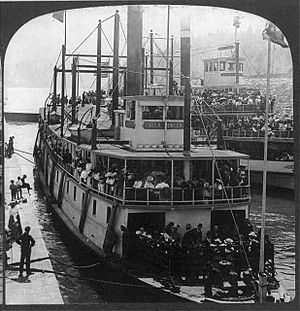
In the spring of 1908, the Gatzert and its rival, the Charles R. Spencer, both started their summer trips on the same day, May 4. People expected a price war between the two ships, which were both in top shape. They raced that day from Portland to Vancouver, Washington and then up the Columbia River Gorge to The Dalles. These two steamboats were said to be the fastest in the world at that time.
Both ships left Portland at 7:00 a.m. The Spencer was in the lead. They passed through the Steel Bridge slowly to follow city rules. But at the Portland Flour Mills, the race truly began! The Spencer held a small lead. But the Gatzert sped up and signaled its intent to pass.
The Spencer kept its lead into Vancouver. It covered the 17 miles from Portland to Vancouver in 65 minutes. Both ships picked up passengers. The Gatzert left the dock first and kept a lead to the Cascade Locks. It passed through the locks before the Spencer.
The Gatzert arrived at The Dalles at 2:32 p.m., with the Spencer arriving 18 minutes later. The Bailey Gatzert left The Dalles at 2:50 p.m. and returned to Portland at 8:05 p.m. The whole round trip took 13 hours and 5 minutes. Neither ship carried any cargo during the race.
In May 1908, both the Regulator Line (which owned the Gatzert) and the Charles R. Spencer cut their ticket prices to $1 for a one-way trip from Portland to Astoria or The Dalles. Captain Ernest W. Spencer, master of the Spencer, even said he was ready to cut the price to 50 cents. He was ready for a fight!
High Water and Racing Concerns
In June 1908, high water on the Columbia River forced the closing of the Cascades Locks. This temporarily stopped steamboat service to The Dalles.
On June 22, 1908, the Gatzert and Spencer raced past a British ship called the Crown of India. The waves they created almost caused the ship to break free from its ropes. The captain of the Crown of India complained. Officials said they needed to stop steamboat racing to prevent damage.
On July 1, 1908, five steamers, including the Bailey Gatzert and Charles R. Spencer, all left Portland at 7:00 a.m. They almost crashed trying to pass through the Burnside Bridge.
On July 4, 1908, all steamboats leaving Portland were completely full. The Bailey Gatzert reached its legal limit of 625 passengers. Customs officials had to stop more than 1,000 people from boarding!
Accidents and Incidents
On October 30, 1895, in very thick fog, the Bailey Gatzert crashed into the T.J. Potter near Kalama, Washington. No one was hurt. The Gatzert had $200 in damage, and the Potter had $50.
On December 29, 1897, the Bailey Gatzert was coming into Portland from Astoria. It was passing through a swinging railroad bridge. The ship signaled for the bridge to open. As it went through, the bridge swung back, hitting the ship's upper structure and trapping it. Most of the 60 passengers were asleep. The bridge was opened again, and the ship continued. Some cabins were crushed, but no one died. Only two people were slightly hurt.
In July 1900, a large fire broke out in Rainier, Oregon. The Bailey Gatzert arrived during the fire. It used its firehose to spray water on the waterfront area. This helped save the dock and other buildings.
On November 1, 1907, the Gatzert hit a reef near Washougal, Washington while on its way to The Dalles. It broke some of its hull planks. The ship was temporarily patched and returned to Portland for repairs in a drydock. No one was hurt. The pilot, J.C. Hastings, was found at fault and had his license suspended for 30 days.
On November 6, 1907, in foggy conditions on the Willamette River, the Bailey Gatzert crashed into a dredge called the Portland. The dredge sank, causing about $10,000 in damage. The Bailey Gatzert had a hole torn in its front, costing about $1,000 to fix. No one died. The investigation cleared the Gatzert's captain of any blame.
Final Years and Legacy
The years after 1911 were the last big era for steamboats on the Columbia River. During this time, the Bailey Gatzert mostly ran special trips up the Columbia Gorge through the Cascade Locks to The Dalles. This was part of the Regulator Line, which was controlled by the Spokane, Portland and Seattle Railway.
In April 1911, a competing company lowered its fare from Portland to The Dalles from $1.00 to 50 cents. The Regulator Line responded by offering better service and faster trips with the Gatzert and another boat, the Dalles City.
By summer 1915, only four main passenger steamers were operating out of Portland. The Bailey Gatzert was one of them, running trips to the Columbia Gorge.
On June 20, 1917, high water forced the closing of the Cascade Locks. But the Gatzert, under Captain Archie Geer, bravely ran through the rapids with 125 passengers on board. This was the first time passengers had been carried through the Cascades Rapids since 1893!
Out of Service
At the end of December 1917, the Gatzert was taken out of service for the winter. In February 1918, its owners announced they would not restart service from Portland to The Dalles. They blamed higher labor costs and the rising price of fuel oil. This decision left the Gatzert and Dalles City without plans.
Return to Puget Sound
On April 10, 1918, the Gatzert was bought by The Navy Yard Route, a company connected to the Puget Sound Navigation Company. It was put on the route between Seattle and Bremerton, Washington. There was a high demand for passenger ferries because of wartime activity at the navy yards.
The Bailey Gatzert arrived in Astoria on April 14, 1918, on its way to Seattle. It left the Columbia Bar on April 17, 1918, being pulled by a tugboat.
In 1920, the Bailey Gatzert was made wider to become an automobile ferry. An elevator was installed to lift cars onto the main deck. Captain Harry Anderson, who later led the Washington State Ferry System, was the captain at this time.
In November 1921, the Bailey Gatzert was replaced on the Bremerton route. Its special four-toned whistle was also moved to the new ferry.
The Gatzert's boiler was repaired in 1923. Some say its last active service was in the summer of 1923. Others say it was still used occasionally in October 1925. By then, the ship was 194 feet long, and its sternwheel was 22 feet wide.
What Happened to the Ship?
Some reports say the Gatzert's machinery was removed in 1926. Another report from May 1929 said the boat was floating without its machinery.
In 1930, the ship's empty hull was sold. A company in Seattle built a four-story structure on the old hull. They used the ship as a floating workshop and drydock in Lake Union.
Remembering the Bailey Gatzert
The Gatzert's unique whistle and its name plate are kept at the Museum of History and Industry in Seattle.
The design of the Bailey Gatzert inspired other steamboats. These include the Rossland built in 1897 in British Columbia, and the M/V Columbia Gorge, launched in 1983. The Rossland was designed by Captain James W. Troup, who was on board the Bailey Gatzert when it was launched in 1890.
In 1996, the Bailey Gatzert was honored by being shown on a U.S. postage stamp. In 2013, a band recorded "The Bailey Gatzert March."
Images for kids


